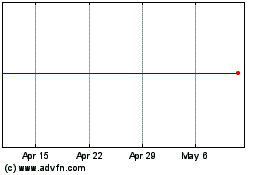Eplontersen granted Orphan Drug Designation in the US for transthyretin amyloidosis
24 January 2022 - 11:10PM
Business Wire
Eplontersen has been granted Orphan Drug Designation (ODD) in
the US by the Food and Drug Administration (FDA) for the treatment
of transthyretin-mediated amyloidosis, a systemic, progressive and
fatal condition.
Eplontersen, formerly known as IONIS-TTR-LRx, is a
ligand-conjugated antisense (LICA) investigational medicine
currently in Phase III clinical trials for amyloid transthyretin
cardiomyopathy (ATTR-CM) and amyloid transthyretin polyneuropathy
(ATTR-PN). It is designed to reduce the production of transthyretin
(TTR protein) to treat both hereditary and non-hereditary forms of
TTR amyloidosis (ATTR).
ATTR-CM is a systemic, progressive and fatal condition that
leads to progressive heart failure and death within four years from
diagnosis.1 It remains underdiagnosed and its prevalence is thought
to be underestimated due to a lack of disease awareness and the
heterogeneity of symptoms.2,3 Hereditary ATTR-PN is a debilitating
disease that leads to peripheral nerve damage with motor disability
within five years of diagnosis and, without treatment, is generally
fatal within a decade.3
The FDA grants ODD status to medicines and potential new
medicines intended for the treatment, diagnosis or prevention of
rare diseases or disorders that affect fewer than 200,000 people in
the US.
Mene Pangalos, Executive Vice President, BioPharmaceuticals
R&D, AstraZeneca, said: “Eplontersen has the potential to be a
best-in-class treatment to halt the progression of
transthyretin-mediated amyloidosis and treat this fatal condition.
The FDA designation further underscores the potential for
eplontersen to offer new hope to this patient population currently
faced with limited treatment options.”
As part of a global development and commercialization agreement
with Ionis Pharmaceuticals, Inc. (Ionis) eplontersen will be
jointly developed and commercialized by both companies in the US,
and will be developed and commercialized in the rest of the world,
except in Latin America, by AstraZeneca.
Hereditary ATTR-PN is expected to be the first indication for
which the companies will seek regulatory approval for eplontersen,
with the potential to file a new drug application with the US Food
and Drug Administration by the end of 2022.
Notes
TTR Amyloidosis (ATTR)
Cardiomyopathy and polyneuropathy due to ATTR are caused by
aging or genetic mutations resulting in misfolded TTR protein and
accumulation as amyloid fibrils in the cardiac myocardium and
peripheral nerves, respectively. In patients with ATTR, both the
mutant and wild type TTR protein builds up as fibrils in tissues,
such as the peripheral nerves, heart, gastrointestinal system,
eyes, kidneys, central nervous system, thyroid and bone marrow.2
The presence of TTR fibrils interferes with the normal functions of
these tissues. As the TTR protein fibrils enlarge, more tissue
damage occurs and the disease worsens, resulting in poor quality of
life and eventually death. Worldwide, there are an estimated
300,000 - 500,000 patients with ATTR-CM4,5 and 10,000 - 40,000
patients with ATTR-PN.2
Eplontersen
Eplontersen is a ligand-conjugated antisense (LICA)
investigational medicine designed to reduce the production of
transthyretin, or TTR protein, to treat all types of ATTR, a
systemic, progressive and fatal disease.
AstraZeneca in CVRM
Cardiovascular, Renal and Metabolism (CVRM), part of
BioPharmaceuticals, forms one of AstraZeneca’s three disease areas
and is a key growth driver for the Company. By following the
science to understand more clearly the underlying links between the
heart, kidneys and pancreas, AstraZeneca is investing in a
portfolio of medicines for organ protection and improving outcomes
by slowing disease progression, reducing risks and tackling
co-morbidities. The Company’s ambition is to modify or halt the
natural course of CVRM diseases and potentially regenerate organs
and restore function, by continuing to deliver transformative
science that improves treatment practices and CV health for
millions of patients worldwide.
About AstraZeneca
AstraZeneca is a global, science-led biopharmaceutical company
that focuses on the discovery, development and commercialization of
prescription medicines in Oncology, Rare Diseases and
BioPharmaceuticals, including Cardiovascular, Renal &
Metabolism, and Respiratory & Immunology. Based in Cambridge,
UK, AstraZeneca operates in over 100 countries, and its innovative
medicines are used by millions of patients worldwide. For more
information, please visit www.astrazeneca-us.com and follow us on
Twitter @AstraZenecaUS.
References
- Lauppe RE, et al. Nationwide prevalence and characteristics of
transthyretin amyloid cardiomyopathy in Sweden. Open Heart. 2021
Oct;8(2):e001755. doi: 10.1136/openhrt-2021-001755.
- González-Duarte A, et al. Impact of non-cardiac
clinicopathologic characteristics on survival in transthyretin
amyloid polyneuropathy. Neurol Ther. 2020;9(1):135-149.
doi:10.1007/s40120-020-00183-7.
- Cortese A, et al. Diagnostic challenges in hereditary
transthyretin amyloidosis with polyneuropathy: avoiding
misdiagnosis of a treatable hereditary neuropathy. J Neurol
Neurosurg Psychiatry. 2017 May;88(5):457-458. doi:
10.1136/jnnp-2016-315262.
- Mohamed-Salem L, et al. Prevalence of wild type ATTR assessed
as myocardial uptake in bone scan in the elderly population. Int J
Cardiol. 2018 Nov 1;270:192-196. doi:
10.1016/j.ijcard.2018.06.006.
- Cuscaden C, et al. Estimation of prevalence of transthyretin
(ATTR) cardiac amyloidosis in an Australian subpopulation using
bone scans with echocardiography and clinical correlation. J Nucl
Cardiol. 2020 May 8. doi: 10.1007/s12350-020-02152-x
View source
version on businesswire.com: https://www.businesswire.com/news/home/20220124005039/en/
Media Inquiries Ashley Boucher +1 302 885 2677 Brendan
McEvoy +1 302 885 2677 US Media Mailbox:
usmediateam@astrazeneca.com
AstraZeneca (NYSE:AZN)
Historical Stock Chart
From Dec 2024 to Jan 2025

AstraZeneca (NYSE:AZN)
Historical Stock Chart
From Jan 2024 to Jan 2025
